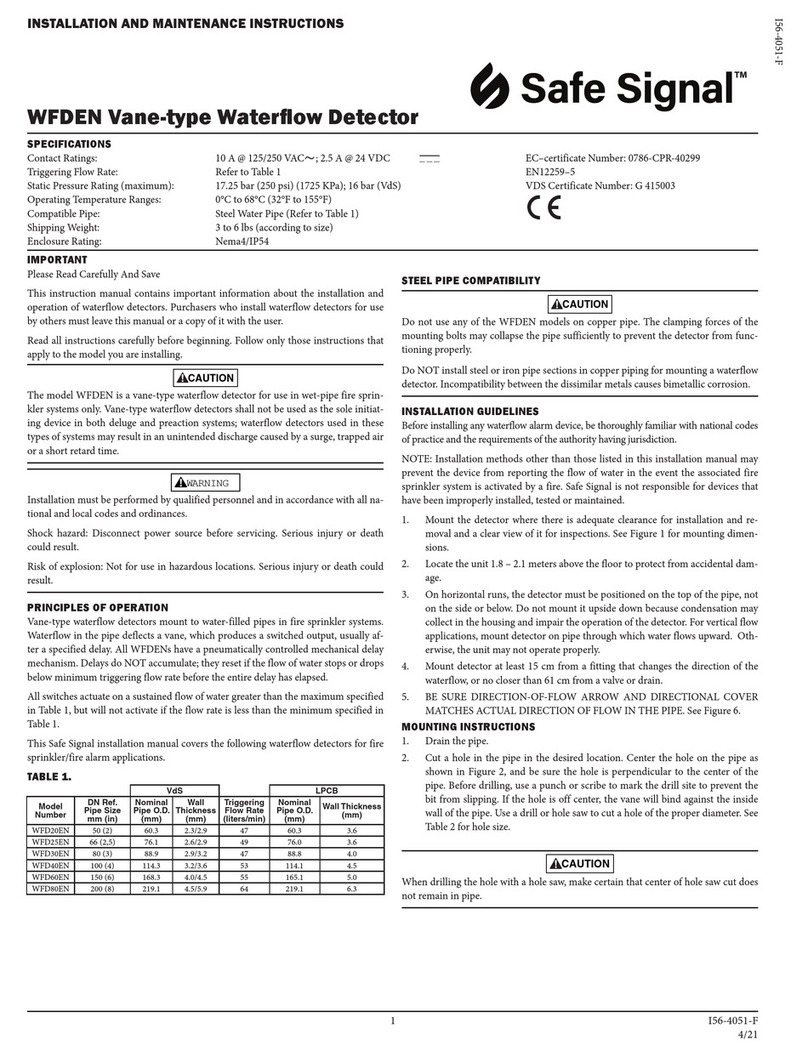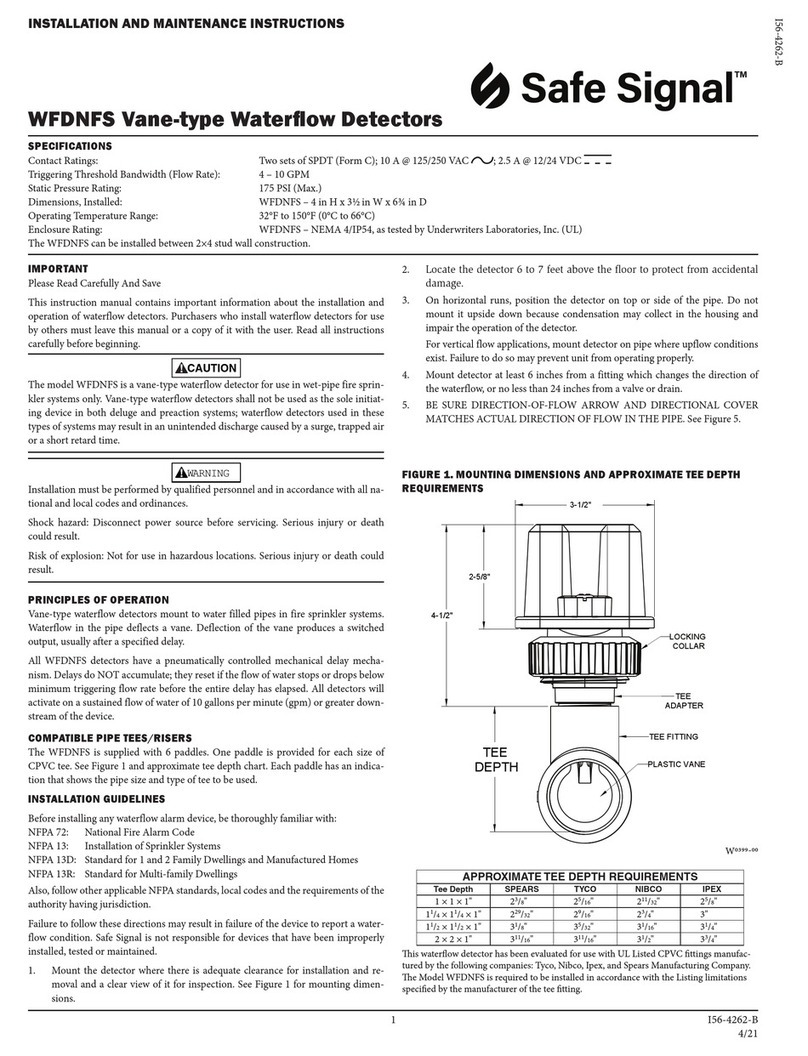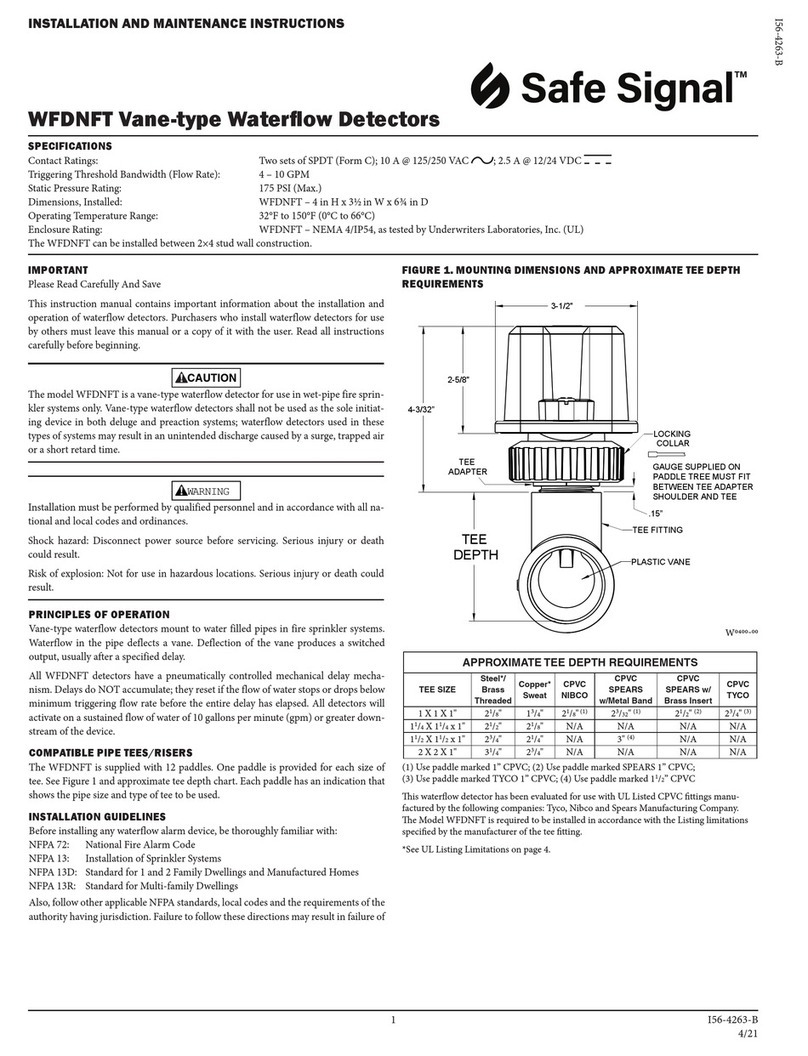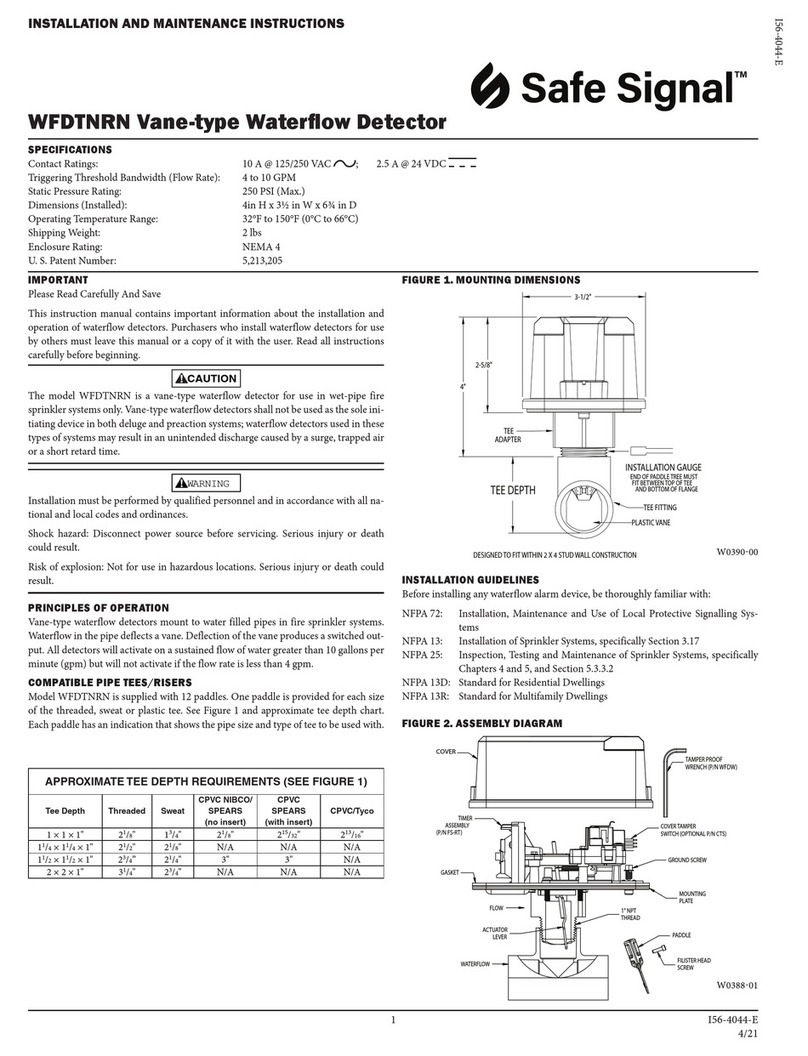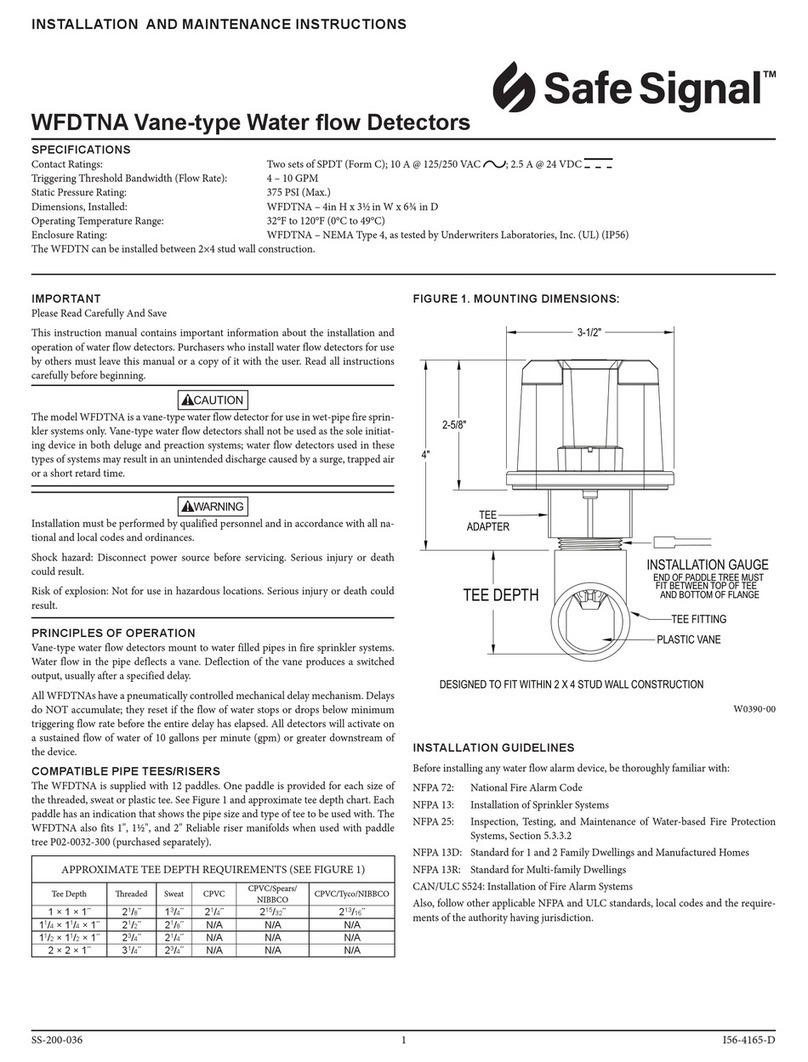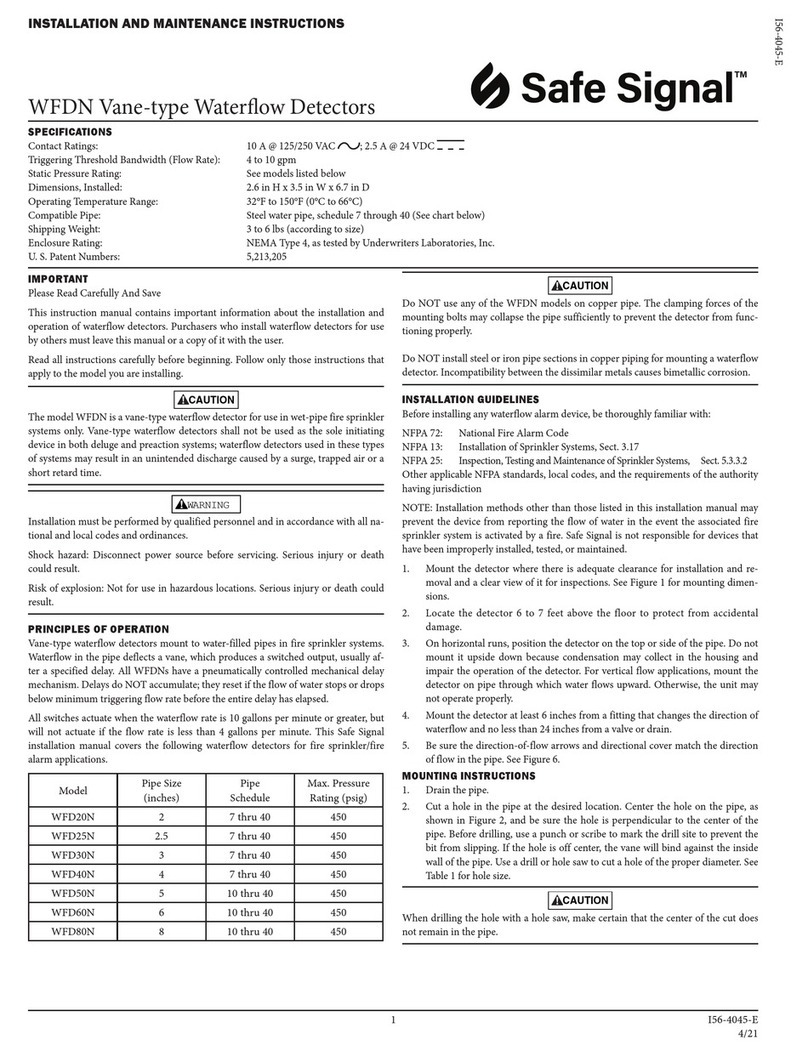
Failure to follow these directions may result in failure of the device to report a water-
flow condition. Safe Signal is not responsible for devices that have been improperly
installed, tested or maintained.
1. Mount the detector where there is adequate clearance for installation and re-
moval and a clear view of it for inspection. See Figure 1 for mounting dimen-
sions.
2. Locate the detector 6 to 7 feet above the floor to protect from accidental damage.
3. On horizontal runs, position the detector on top or side of the pipe. Do not
mount it upside down because condensation may collect in the housing and
impair the operation of the detector.
For vertical flow applications, mount detector on pipe where upflow conditions
exist. Failure to do so may prevent unit from operating properly.
4. Mount detector at least 6 inches from a fitting which changes the direction of
the waterflow, or no less than 24 inches from a valve or drain.
5. BE SURE DIRECTION-OF-FLOW ARROW AND DIRECTIONAL COVER
MATCHES ACTUAL DIRECTION OF FLOW IN THE PIPE. See Figure 5.
FIGURE 2. ASSEMBLY DIAGRAM
COVER
FLOW
COVER TAMPER
SWITCH (OPTIONAL P/N CTS)
TIMER
ASSEMBLY
(P/N FS-RT)
GASKET
ACTUATOR
LEVER
WATERFLOW
GROUND SCREW
MOUNTING
PLATE
PADDLE
1" NPT
THREAD
TAMPER PROOF
WRENCH (P/N WFD
FILISTER HEAD
SCREW
MOUNTING INSTRUCTIONS
1. The WFDTN waterflow detector is designed to fit only the appropriate tee fit-
ting.
NOTE: The outlet branch of tee must have a 1-inch NPT thread. Do not use a
reducer to achieve the correct thread size. Failure to follow this instruction will
result in failure of the detector to report a waterflow condition.
2. WFDTN units are shipped without paddles mounted to the actuator. Select the
correct size paddle for the type of tee being used. Align hole on stem of paddle
with hole on actuator lever. Fasten together using a #4-40×3/8-inch fillister head
screw supplied in bag assembly. See Figure 2. Use only the screw provided with
the unit. Drive screw head through hole in paddle until it seats to actuator lever
surface. No washer is required. For paddle replacement refer to Maintenance
section.
3. Carefully roll the vane opposite the direction of flow and insert through tee.
Thread detector onto tee fitting and tighten with wrench. Use of thread seal-
ant or tape is recommended. Use height gage (located at end of paddle tree) to
ensure proper depth of detector on tee fitting. See Figure 1. Height gage must fit
between top of tee fitting and under side of hex tee adapter. A gap between gage
and tee adapter is acceptable. When correctly installed, the detector must face
in the proper direction of waterflow and be aligned with the pipe, the provided
directional cover illustrates flow direction for device.
4. Remove the cover. Move the actuator lever back and forth to check for binding.
If the vane binds, remove the detector and correct the problem before proceed-
ing.
Be sure the direction-of-flow arrow and directional cover point in the right direction, other-
wise a waterflow condition will go unreported. See Figure 2 and Figure 5.
PREOPERATION TESTING
1. Fill the sprinkler system with water and check for leaks around the WFDTN. If
there is a leak, check to see that the fittings are tight. If leak persists, drain the
system and remove the detector (see removal instructions under Maintenance).
Check for damaged threads or cracked fitting. Reinstall the detector and check
again for leaks. Do not proceed until all leaks have been stopped.
2. Connect an ohmmeter or continuity tester across (COM and B-NO) terminal
switch contacts. The ohmmeter should show an open circuit, no continuity.
3. Deflect the actuator lever and hold it until the pneumatic delay shaft releases the
switch buttons. The ohmmeter or continuity tester should show a short circuit
after the delay has elapsed. If there is no delay, check the setting of the delay
adjustment dial.
FIELD WIRING
High Voltage. Electrocution Hazard. Do not handle live AC wiring or work on a de-
vice to which AC power is applied. Doing so may result in severe injury or death.
When utilizing switches at voltages greater than 74VDC or 49VAC
means to provide all–pole disconnection must be incorporated in the fixed wiring,
such as a circuit breaker.
1. The WFDTN has two SPDT switches. Switch contacts (COM and B-NO) are
closed when water is flowing and open when water is not flowing. Connect the
switches as shown in Figure 6 depending on the application.
2. When connected to a listed sprinkler/fire alarm control panel, the initiating cir-
cuit must be unable to be silenced.
3. A ground screw is provided with all units. When grounding is required, clamp
wire with screw in hole located between conduit entrance holes. See Figure 3.
4. Use proper waterproof conduit fittings where required.
W038801
2 I56-4043-D
4/21






